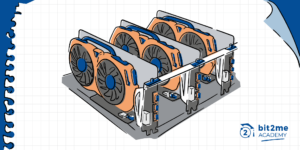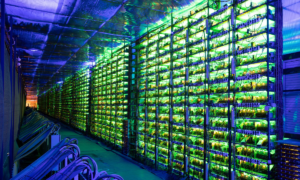Bitcoin (₿) is a cryptocurrency, a form of electronic cash. It is a decentralized digital currency without a central bank or single administrator that can be sent from user-to-user on the peer-to-peer bitcoin network without the need for intermediaries.
Transactions are verified by network nodes through cryptography and recorded in a public distributed ledger called a blockchain. Bitcoin was invented by an unknown person or group of people using the name Satoshi Nakamoto and released as open-source software in 2009. Bitcoins are created as a reward for a process known as mining. [1]
Bitcoin utilises a decentralised peer-to-peer protocol to store money or value as information on a publicly verifiable ledger. For everyone to come to agreement on the shared Bitcoin ledger, Satoshi Nakamoto, the inventor of Bitcoin and author of the Bitcoin Whitepaper implemented a proof-of-work (POW) consensus algorithm called SHA-256. Bitcoin Mining uses this proof-of-work (POW) to keep the network secure and decentralized.
Bitcoin was the first truly decentralized money to gain success globally.
What is Proof-Of-Work (POW)?
A proof of work is a piece of data derived that is difficult to produce, it’s like a solution to a complicated equation that cannot be computed with traditional means, so instead the computational power directed at mining a POW coin has to guess the answer until it finds the solution that fits. The solution must be trivial to verify, so that all nodes on the network can quickly check that each new block broadcast is a legitimate solution. On the flipside the solution must be adequately difficult to discover, so that it requires a sufficient amount of computational “work” to create each new block, which helps keep the network secure and virtually unhackable.
Proof-of-Work is the first workable solution to the double spending problem at scale. Previous digital monies have been centralized, giving the creators excessive power over the network, centralization creates a tangible target to attack and as such centralized digital monies of the past were rather easy to shut down.
CPU vs GPU vs ASIC Mining

Bitcoin mining originally started using CPUs, the central processors of regular PCs and laptops, however within a couple of years miners started developing ways to utilise the greater computational power of Graphics Cards that were up until that point primarily used for video games, video editing and 3D CAD applications.
Graphic cards contain a very powerful core processor called a Graphic Processing Unit (GPU) with its own state-of-the-art fast DDR memory, and are thus far more effective at mining than CPUs. As Bitcoin’s popularity gained traction, more powerful GPUs joined the network making CPU mining less and less profitable until it was no longer profitable to mine Bitcoin with CPUs.
While GPUs were dominating the hashing power on the Bitcoin network, some new chip manufacturers arose that began designing and manufacturing specialised processors made specifically with one use in mind, to efficiently mine Bitcoin. This specialised hardware is known as an ASIC, which stands for Application-Specific Integrated Circuit. The first Bitcoin ASICs were released in 2013 and have since been improved on almost yearly. Nowadays, with newer Bitcoin mining ASICs being more efficient than earlier models, this has rendered older ASICs unprofitable to mine Bitcoin as they use more electricity than the amount of mined Bitcoin they produce. These days there are many different exciting alternative coins (Alt Coins) that can be mined for a healthy profit on GPU rigs, instead of mining Bitcoin itself.
GPU miners are generally much quieter, have more use-cases, a higher resale value and often use less electricity than ASIC miners.
For those new to Bitcoin & Cryptocurrency Mining, here’s a few very important things you must know….
- You can mine Bitcoin indirectly, without actually mining Bitcoin! There are now hundreds of alternative Cryptocurrencies that can be mined profitably on current generation GPUs and CPUs, and those coins can be regularly traded for Bitcoin. Over the past few years this has become a very popular and often far more profitable way of mining Bitcoin. In 2017 & 2018, the technique of mining undervalued alt coins (eg. Ethereum, Monero, Zcash, LOKI, etc) and trading them for Bitcoin once their values rise has been one of the most profitable mining strategies since the birth of Bitcoin. Put simply this technique is: Mining the most profitable coin for your mining equipment – either (1) using Nicehash miner which automatically mines profitable coins and pays out in Bitcoin OR (2) for maximum profit doing this manually yourself by utilising a mining calculator like WhatToMine.com or CoinCalculators.io and then trading those mined coins for Bitcoin on an exchange.
- It is generally considered that ASIC mining equipment investments are much riskier than setting up a GPU mining rig or farm. Firstly, one of the largest and most popular ASIC mining manufacturers on the planet, Bitmain, has a less than stellar record when it comes to the interest of their customers. It is strongly believed (with much evidence to back the claims) that the largest ASIC manufacturer Bitmain, mines using the machines that their customers have pre-ordered and pre-paid for, to mine coins for themselves for often many months before actually shipping these units to their eagerly awaiting customers. By the time their customers receive the miners, the network difficulty has increased so profit numbers aren’t anywhere near the levels that they were when the customer paid for their ASIC miner pre-order.
- As ASIC miners are designed to do one thing only – mine Cryptocurrency – they become antique useless pieces of junk hardware once they’ve become unprofitable to mine with, effectively killing any resale value once this happens. Whereas GPU Graphic Cards have a large market of PC gamers, video editors and CAD designers that buy used graphic cards for a healthy price 1-2 years after they’ve been used to mine coins profitably. In the past, a new graphics card bought for about $400 can often be sold for about $200 or more even after used for 2 years.
Block rewards (Coin Emission)

The total amount of Bitcoin is capped at a maximum supply of 21million. The block reward that occurs approximately every 10 minutes started in 2009 at 50 BTC per block and halves every 210,000 blocks or roughly every 4 years. Currently, the block reward is 12.5 BTC and is expected to halve again in 2021 to 6.25 and in 2025 the Bitcoin block reward will reduce to 3.125 BTC.
The below chart shows Bitcoin’s emission schedule, illustrating the changes to the block reward over time, starting at 50BTC per block in 2009 that halves about every four years (every 210,000 blocks).
Other Cryptocurrencies use a range of various coin emission schedules, with some following Bitcoin’s emission very closely or matching it exactly. The problem with Bitcoin’s emission schedule is that the early miners benefit massively more from having the largest block rewards from Day 1 and the initial very low POW difficulty, assisting them to accumulate a highly disproportionate share of the total supply.
Some cryptocurrencies have attempted to create a more decentralised emission structure than Bitcoin. RYO Currency for example uses a “camel emission” structure that aims to lessen the centralised effect of giving such a massive reward benefit to the earliest miners.
Bitcoin mining has become more than just mining Bitcoin. There are many other promising mineable Cryptocurrency projects that offer potential for outstanding long-term mining ROIs.
What is a 51% Attack?

A 51% attack is a situation where a single miner or group of miners working together gain more than 50% of the total network mining power. If this happens and can be sustained for an amount of time over many blocks, it can allow a potential “double spend” attack. Bitcoin has never had a successful 51% attack double spend. However, some other Cryptocurrencies such as Bitcoin Gold (BTG) and Zencash / Horizen (ZEN) have had successful 51% attack double spends occur on their networks in the past. These networks have a far lower total network hashrate that enabled attackers to hire enough hashing power to implement the attack.
The attack works like this…. We’ll use Zencash as the example… The attacker obtains more than 50% of a networks total hashrate (through renting a very large amount of mining power on NiceHash or MiningRigRentals). The attacker would then ‘secretly’ mine more blocks than the rest of the network but not broadcast the blocks they find, then they would send a large amount (say $20 million) of that network’s coins (eg. Zencash) to an exchange and once confirmed trade those coins for another coin, say Bitcoin or Monero, then they would withdrawal all those coins from the exchange. While they are waiting for the withdrawal coins to confirm into their wallet, they would continue secretly mining blocks faster than the public Zencash blockchain. Once their withdrawal is fully confirmed and they’ve received the $20million in say Bitcoin or Monero. They then erase their original deposit transaction from their secret mined blocks and broadcast all these blocks to the public Zencash blockchain. The nodes on the Zencash blockchain see the new blocks and because they now see more mined blocks in the attackers version of the blockchain, this longer chain now becomes the real blockchain. This is due to the widely-used consensus rule of “the longest chain with the most Proof-of-Work is the real blockchain”. This longer chain then starts to propagate through the network to gaining consensus to become the real blockchain. However the first $20million Zencash deposit transaction to the exchange is now erased from the ledger, which is basically like it never happened at all and causes those coins to disappear from the exchange’s wallet and appear again in the attackers wallet, along with the new coins the attacker withdrew, thereby successfully completing the 51% double spend attack.
Currently the chance of a 51% attack (that could enable a double spend) on the Bitcoin network seems extremely unlikely due to the decentralisation of mining power spread across many different ASIC manufacturers, mining farm facilities, individual miners and mining pools. Decentralisation is about removing control and censorship power from centralised forces, and when it comes to Bitcoin this means it should aim to at all costs avoid a potential 51% attack by continuing to decentralise mining power. As the Bitcoin network has been maturing, more mining manufacturers have emerged offering healthy decentralised competition to the once majority player in Bitcoin mining, Bitmain.
Many alternative cryptocurrencies (such as RYO Currency) are building 51% attack resistance into their POW code, to make such an attack almost impossible to pull off in the future, even after obtaining more than 50% of the network’s total mining power.
Conclusion
We believe Proof-of-Work mining plays a vital role in the Decentralisation of Bitcoin & Cryptocurrencies and is helping to create a more decentralised distribution of wealth and power, being non-reliant on the draconian central-banking laws and practices of the past and present. We believe there is and will continue to be exceptionally profitable mining opportunities going forward with GPU mining the best up-and-coming alt coins.
We offer Mining Rig Sales, Spare Parts, Remote Rig Tuning, Mining Consulting, Node Hosting & Rig Maintenance Services.
Join our knowledgeable mining community to keep up-to-date with all things Bitcoin & Crypto mining via our Discord channel or Contact Us to inquire about any of our services.
Written by Stephen from Dapp.tech. Sources [1] Wikipedia: Bitcoin – https://en.wikipedia.org/wiki/Bitcoin
